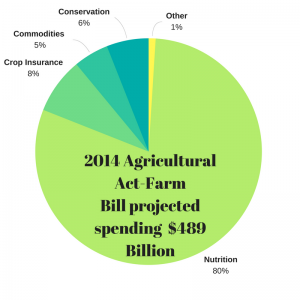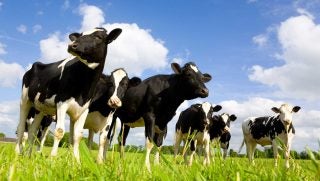Gone are the days where producing food for the population was the only duty farmers had. Agriculture has become an increasingly complex industry over the past few decades: From precision Ag to political policies, there are a multitude of sectors that farmers and ranchers require knowledge of, and education in. Emerging producers face a lot of challenges when it comes to breaking into the industry, including finding land and understanding regulations that affect agriculture as a whole.
Beginning farmers and ranchers should be familiar with the Farm Bill, also known as the Agricultural Act — an intricate piece of legislation passed by Congress and revised every four to six years, governing numerous federal programs.
The current Farm Bill from 2014 expired in September of 2017. Voting for the 2018 act isn’t expected to begin until February of 2018. The joint governing jurisdiction of the bill falls under the House Committee on Agriculture and the Senate Committee on Agriculture, Nutrition and Forestry. A significant aspect of the Farm Bill is that it handles reform and support for programs for farmers and industries indirectly involved in agriculture — meaning, it is not only important to you as a farmer or rancher, but as a consumer in general. The 12 “titles,” or sections, that make up the structure of the bill encompass topics such as conservation, commodities, nutrition, and crop insurance, to name a few. Each section has a budget limit that legislators spend countless hours negotiating.
Below is a breakdown of title spending in the 2014 Farm Bill, to give you an idea of how the funding is spread out:

As you can see, nutrition gets a huge chunk of the pie. This portion deals with food programs such as the Food Distribution Program on Indian Reservations, the Emergency Food Assistance Program, and the Commodity Supplemental Food Program, among many others. The importance of this portion is that it is highly controversial between parties who are fighting for funding of their programs. The Supplemental Nutrition Assistance Program — better known as SNAP — is the largest program under the nutrition title. (These programs also get lumped into the broad category of “food stamps.”) The nutrition programs provide millions of low-income families access to healthy food. With the 2018 Farm Bill, there’s an expected reform that should help balance out funding. However, this causes tension among political parties, and in the past Farm Bill, a $20 billion reduction in funding for SNAP failed. For more information on the specifics of individual programs, click here.
Following behind nutrition are crop insurance and commodities on the spending scale, and they will be of a particular focus in this Farm Bill because commodity prices and funding are currently down. Crop insurance includes programs that support smaller revenue/yield losses and traditional insurance policies. These programs include the Supplemental Coverage Option, the Stacked Income Protection Plan, and several others you can read about here. The policy covers over 90 percent of major crops.
In 2018, talks to decrease federal funding for specific crop insurance premiums covered by the government will most likely be discussed. The important thing to remember is that this area is targeted most to reduce funding, which has a negative effect on farming operations.
Other notable actions to be discussed by lawmakers are the dairy and cotton commodities. Cotton was denied access to the Agriculture Risk Coverage and Price Loss Coverage insurances in the 2014 act, this due to a legal issue. Instead, a new special crop insurance program was created, titled STAX, to assist cotton farmers. This program hasn’t been as effective as producers hoped, so allowing cotton to qualify, and allowing cottonseed to be designated as an oilseed, for ARC and PLC, will be proposed. The 2014 act also eliminated support for dairy farmers and created a program to aid farmers when differences between the price of milk and feed costs fell below certain levels. The program, similar to STAX, hasn’t gone over well with the dairy industry, and therefore, adding more funding to the MPP — the dairy Margin Protection Program — will be sought out. Other insurance and commodity topics expected to be discussed are found in this link.
Sustainable farming is a huge topic, so you can be certain it will be discussed in length during Farm Bill talks. Conservation support was cut in the 2014 Farm Bill, which has hindered efforts of farmers to preserve the environment while still making a profit on their crops. The platform for 2018 includes expanding access to working lands conservation programs; targeting dollars to the most effective conservation activities and systems; improving support for outreach, planning, and implementation of conservation efforts; and increasing measurement, evaluation, and reporting of program outcomes. These goals will be reached through programs such as the Environmental Quality Incentives Program, the Conservation Stewardship Program, and others. Here is a more detailed list of reform plans during the farm bill.
Trade, rural development, credit, research and extension, forestry, horticulture, energy and miscellaneous make up the rest of the titles, and they only make up 1 percent of the total budget. For beginning farmers, this slice of spending is important because it is where you fit into the budget and where spending is considered to support startup farms. One important thing to note is that this portion is steadily growing, although only currently a sliver, efforts to expand this area are continuous. Some plans for this Agricultural Act include expanding access to credit, insurance, and cropland, as well as outreach services to underserved communities. However, this is a section that is at risk for decreased funding and needs to be protected as well as expanded. Follow this link to read up more on reform plans that can assist beginner farmers.
All this talk of reform sounds expensive, right? As a beginner farmer, budget plays a massive role in your success. The same goes for the Agricultural Act. Every policy set forth has to be approved in the budget, which isn’t exactly expandable. While many programs are authorized on the Farm Bill and receive mandatory or direct funding; for others that is only the first step into getting funding. Once they are on the bill, they have to be implemented through appropriations. These can be granted throughout the year, even though the act is passed only every four to six years. This means some programs won’t ever be used in the real world even though they appear on the bill. The huge factor to a budget involves participation in each program, economic conditions, and many other factors. Regardless, all this needs to be approved by Sept. 30, 2018, or extensions will be required to ensure programs don’t run out of funding.
Due to this piece of legislation being so complex, covering all of the aspects can be overwhelming. This link delves deeper into “marker bills,” Congress members, and various other factors that determine the agricultural acts funding. Success as a beginning farmer entails being knowledgeable not only in farming practices but also in knowing what your representatives are lobbying for, understanding how the agricultural act is structured and funded, and recognizing that the Farm Bill affects producers as well as the consumers we’re selling products to.
If you’re curious how a farm bill becomes law, below is an abbreviated explanation.

Markie Hageman is a senior, majoring in agribusiness, at Fort Hays State University. She is actively involved in her state Cattlemen’s Association, Young Farmers chapter, and National Cattlemen’s Beef Association. Follow her series exploring various parts of the next Farm Bill.



